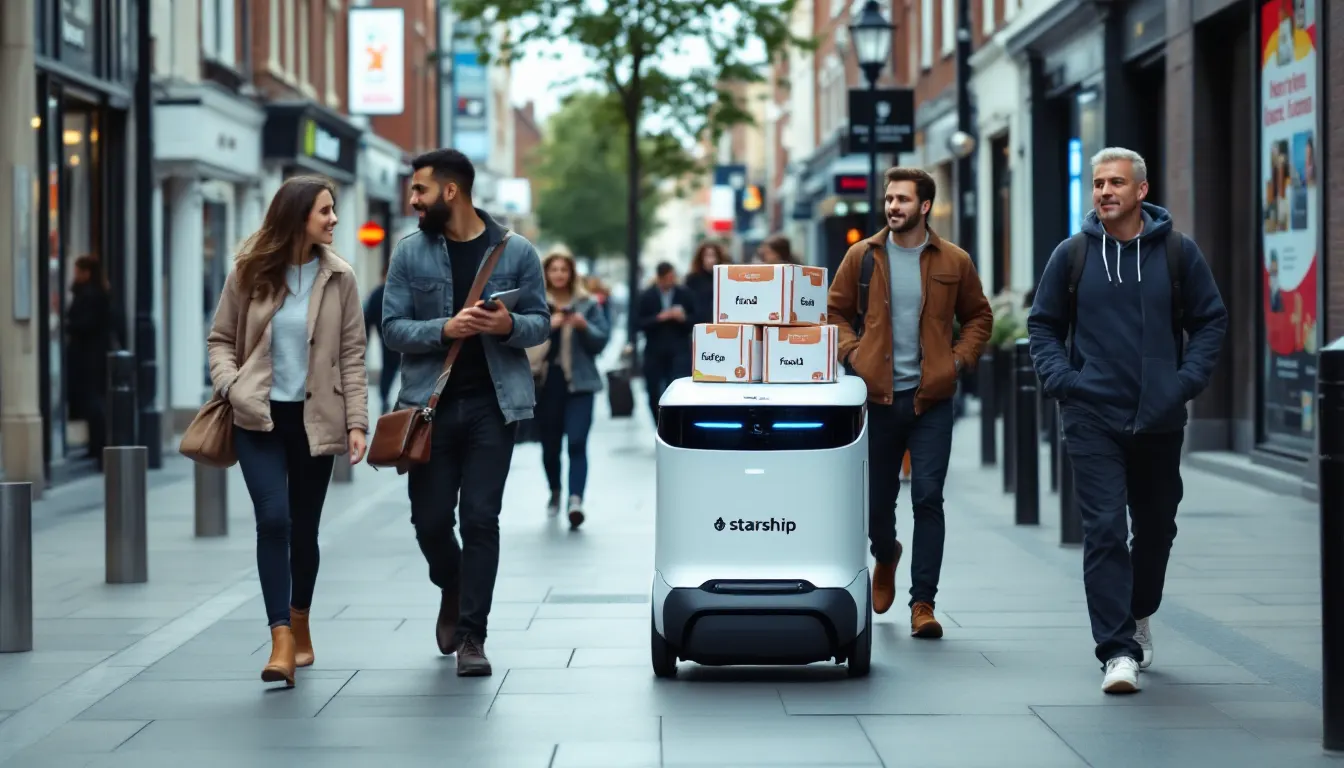Why UK Embraced Uber Eats’ Starship Robot Deliveries First

Sidewalk delivery robots are still niche globally, but the UK is set to deploy Uber Eats and Starship Technologies’ robots at scale in 2025, ahead of wider European and U.S. launches in 2026 and 2027.
This roll-out starts in UK cities this year, creating the first large-scale integration of autonomous sidewalk delivery into an existing food logistics network.
But this isn’t a simple automation upgrade—it’s a levered repositioning of delivery constraints that exploits urban density, regulatory environment, and last-mile cost structures.
“Logistics that work without human drivers unlock compounding efficiency that scales itself.”
Why This Isn’t Just Cost Cutting
Conventional wisdom says robot delivery is about cheap labor replacement. Analysts expecting immediate margin improvement miss the key shift: constraint repositioning.
Uber Eats could have kept pushing driver incentives or expanded car delivery fleets, like DoorDash in the U.S.. Instead, it partnered with Starship to deploy autonomous robots that operate on sidewalks, bypassing vehicle congestion.
Unlike countries with sprawling suburbs and weak pedestrian infrastructure (e.g., much of the U.S.), the UK’s city layout favors sidewalk navigation, drastically reducing delivery friction and time.
This strategy reframes delivery costs from human drivers paid per trip to scalable infrastructure utilization with minimal incremental cost.
Explore more on strategic partnerships and how they enable growth.
Concrete Lever Mechanics in the UK
Starship’s robots handle multiple orders simultaneously on optimally planned routes, all autonomously. This is unlike Amazon Scout, which targets limited geographic trials, or food couriers who handle one order at a time.
In dense UK cities, the robots’ lower speed but continuous operation beats vehicle drivers in reliability and cost per delivery. This converts expensive last-mile labor into a software-defined asset.
Competitors like Just Eat rely heavily on human couriers, facing rising wages and burnout. Uber Eats' decision creates a scalable logistics platform that self-optimizes as more robots join the fleet.
For process-level leverage, see business process automation frameworks.
Why The UK Lead Matters Globally
The real constraint isn’t just tech readiness—it's urban regulatory openness and pedestrian infrastructure quality. The UK’s more permissive sidewalk robot regulations and pedestrian-friendly cityscapes proved critical.
With plans to expand to other European cities in 2026 and the U.S. in 2027, this staged deployment sequence reveals how geography and policy shifts dictate strategic technology adoption timelines.
Regions ignoring urban design and legal frameworks will face higher costs and longer time to ROI.
Leaders must reimagine delivery not as a labor battle but as a system design problem unlocking new operational leverage.
See resource optimization tactics for additional context.
The New Constraint Is Autonomous Freight Networks
Uber Eats and Starship prove scaling robot delivery hinges on solving urban corridor navigation combined with a tech-enabled centralized dispatch.
This operational shift forces rivals to choose: invest in similar robot fleets or double down on costly human delivery.
Urban areas globally with dense sidewalks—from London to Paris and Tokyo—stand to replicate this as infrastructure and regulations evolve.
“Automated delivery turns sidewalks into scalable logistics superhighways.”
Related Tools & Resources
Implementing autonomous delivery robots at scale requires precise operational workflows and clear process documentation. This is exactly why platforms like Copla are essential for operations teams aiming to streamline and standardize their SOPs in complex logistics environments. For businesses looking to leverage innovative delivery methods while maintaining consistency and efficiency, Copla offers a practical solution to drive scalable process management. Learn more about Copla →
Full Transparency: Some links in this article are affiliate partnerships. If you find value in the tools we recommend and decide to try them, we may earn a commission at no extra cost to you. We only recommend tools that align with the strategic thinking we share here. Think of it as supporting independent business analysis while discovering leverage in your own operations.
Frequently Asked Questions
Why is the UK leading in autonomous sidewalk delivery robot adoption?
The UK's urban density, pedestrian-friendly infrastructure, and permissive regulations enable large-scale deployment of autonomous delivery robots, with Uber Eats and Starship planning widespread rollout from 2025, ahead of Europe and the US.
How do sidewalk delivery robots improve last-mile delivery efficiency?
By operating autonomously on sidewalks, robots bypass vehicle congestion and reduce delivery friction and time, converting costly per-trip labor into scalable infrastructure with minimal incremental cost, as demonstrated in UK city deployments starting in 2025.
What makes Starship Technologies robots different from other delivery options?
Starship's robots autonomously handle multiple orders on optimized routes continuously, unlike human couriers who manage one order at a time or Amazon Scout's limited geographic trials, improving reliability and cost per delivery especially in dense urban areas.
When will autonomous delivery robots launch in Europe and the US after the UK?
Following the UK's 2025 startup, wider European launches are planned for 2026, with US deployments expected in 2027, reflecting staged rollout aligned with urban design and regulatory readiness.
What challenges do competitors relying on human couriers face?
Companies like Just Eat face rising wages and courier burnout, whereas robot delivery offers a scalable logistics platform that self-optimizes as robot fleets expand.
How does urban design affect robot delivery effectiveness?
Dense city layouts with quality pedestrian infrastructure—such as in UK cities—favor sidewalk navigation and reduce delivery time and friction, making autonomous robots more efficient than vehicle-based deliveries.
What strategic benefits do businesses gain from deploying delivery robots?
Businesses unlock compounding efficiency that scales itself by repositioning delivery constraints, leveraging urban design and regulatory environments to create scalable, software-defined last-mile logistics assets.
What role do strategic partnerships play in robot delivery deployment?
Partnerships like Uber Eats with Starship Technologies enable combining autonomous robot technology with existing food logistics networks, accelerating integration and operational leverage in robot delivery.

